I. A Line Between Modes… Somewhere
The United States has two major agencies that regulate trains. The first is predictable: The Federal Railroad Agency (FRA) regulates all mainline freight and passenger railroads in the US. This includes all of the freight trains you see, plus almost all commuter railroads, plus specifically the Port Authority Trans Hudson Railroad (PATH).
The other is the Federal Transit Agency (FTA). It regulates all subway trains (think New York or Chicago), all light rail trains (LA and Seattle), plus Trolleybuses (Seattle/SF), Bus Rapid Transit, and local buses. The grey area exists in heavy passenger railroads. Trains which are fast (~80mph), carry passengers, and use regular looking trains could in theory be regulated by both. The practical distinction is whether the agency is connected to the national rail network. If it is, that’s governed by the FTA. If not, it’s an FRA system.
This is… sort of ridiculous. For example, the train on the left is a BART train. It can travel at 80mph, and lines can stretch over 30 miles, and is governed by the FTA. On the right is a PATH train. It runs 10 miles, has a maximum speed of 55mph, and is governed by the FTA. The reason for this is in the picture. The other train is the Acela Express, which runs at up to 150mph, and travel between DC and Boston, nearly 400 miles.
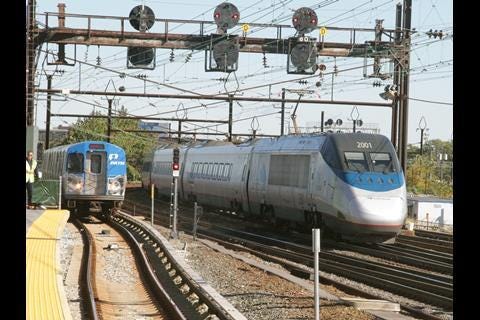

PATH is special, because it is realistically a subway system but governed by the FRA. That’s because it has a track connection to the rest of the US, so despite its subway like appearances it falls under the FRA’s jurisdiction. PATH was designed in the 1880s, when there was no FRA, as a rapid transit system explicitly designed to replace a ferry and connect three mainline railroad terminals to Midtown.
Because PATH was explicitly designed to act as a subway system, the FRA granted an enormous amount of waivers to allow it to act as such. These waivers are unfortunately not replicable, as the Illinois Central railroad found out after WWII.
II. Annals of Passenger Railroad Collapse (Unions)
The Illinois Central (IC) operated a six-track mainline into Chicago, and passengers arrived at Millennium Station, two blocks away from the loop. In the early 1900s, traffic became so intense that railroad crossings were mostly down, so the City of Chicago was forced to act. It paid for grade separation, allowing traffic to flow beneath while the trains didn’t face a single railroad crossing between Downtown and University Parkway, over 25 miles away.
Because so many of those trains carried commuters, the IC electrified the mainline into Chicago in 1926. Ridership set an all-time high in 1946 and then began to decline, so the railroad looked for ways to modernize operations while lowering costs. Noticing that the railroad was both grade separated and electrified, like a subway system, the Illinois Central began planning to operate their electric district as a subway system.
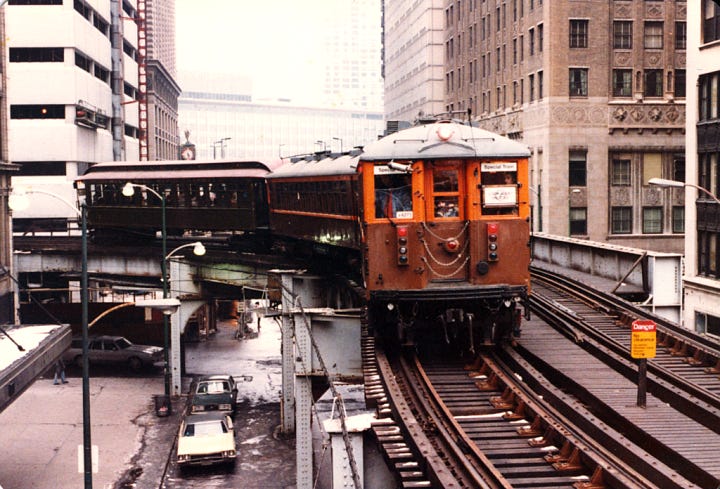
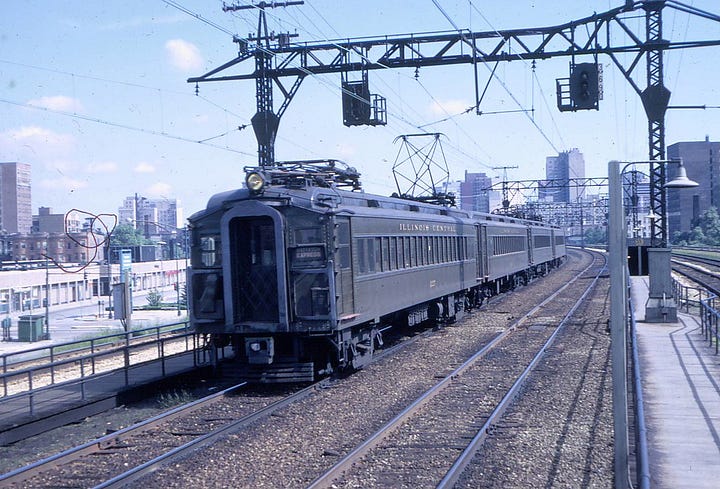
That meant high platforms, fare gates, ticket machines, and all-day service. Most importantly, it meant each train could have only a single operator. The other equipment would render conductors, who check tickets, useless. So they presented their plans to do this to the FRA, who said no.
Negotiations with the FRA over the years meant that the minimum crew requirement for a passenger train was three. The IC did not manage to convince the FRA that commuter trains were similar to the FTA trains in Chicago, which already had all of those attributes. (The deciding factor was that the unions were against it, because it would cost them their jobs)
By 1976, enough was enough. Despite the ICC mandating otherwise, the IC threatened to simply stop operating the now-unprofitable commuter trains. The city caved, and the Regional Transportation Authority gave them a subsidy. Eventually, they also took over branding, and the service is known today as Metra Electric.
III. Duplicative Disasters
In other words, historical circumstances locked in place by unions mean commuter trains are stuck in a labor-intensive operating paradigm. Passenger trains on mainline rail (FRA) are forced to operate with labor-intensive practices and are mostly forced to comply with excessive crash standards. Meanwhile, trains with more efficient practices (FRA) cannot use existing tracks (FTA) because that imposes the stricter crash standards and worse operating practices.
As a response to this situation, most cities have two separate transit agencies. One operates the subways and city buses, while the other operates the commuter trains, which are primarily for the suburbs but also stop in cities. Metro North/LIRR vs NYCTA in New York, T vs MBTA in Boston, Metra vs CTA in Chicago, BART vs Caltrain in San Francisco, and so on.
These systems have to be isolated from each other, so when a transit agency wants to extend along tracks owned by a commuter railroad, they have to literally build separate tracks. This is, as you might expect, hugely wasteful. In Boston, the green line extension managed to spend $2.3 billion extending light rail along an existing commuter rail right of way.
That makes lots of easily doable projects impossible. For example, there is existing track along the MARC Camden line connecting Greenbelt (WMATA green line) to within a mile of BWI airport. If no agency boundary existed, subway trains could simply proceed along existing tracks to a new one-mile line connecting it to the airport. The project could be done in $1-2 billion if WMATA also bought dual mode trains to operate the extension.
However, because of the agency split, WMATA can’t use any of those tracks. The project would instead require rebuilding subway track, and if the Boston example is anything to go by, it would cost tens of billions of dollars. Heck, the agency boundary prevents people from thinking this way, because BWI is out of range of a traditional subway, and that’s that.
IV. Planning for the future, or not
The thing is, the FRA and FTA don’t just pass regulations. They also supervise grants, which are handed out to various agencies and railroads for improvements. The biggest of which are the most recent - Joe Biden’s Infrastructure bill funded tons of project and distributed money in part through these two agencies. Because both fund rail projects, but the agency barrier prevents direct comparisons, this results in some interesting splits.
One example of which is in Chicago. Like most cities, Chicago has two transportation agencies split along FRA/FTA lines: Metra and the CTA. Both had their priorities going into the grant making process.
Metra wanted a program known as the Chicago Hub Improvement Program (CHIP), which cost $1.1 billion and would have improved Union Station, rebuilt several interchanges to speed up commuter trains, and brought Rock Island trains to Union Station. It would also allow Amtrak trains leaving to the south to arrive directly at Union Station without U-turning.
The CTA came into the process wanting to eXtend the Red Line (RLX. Yeah, I know.) The project is an atrocious waste of money, and goes to low density suburbs plus a wastewater treatment plant (yes, I’m serious). However, it was competing with the $7.7 billion Second Avenue Subway and the $9 billion dollar San Jose Bart projects. So the FTA funded a bunch of smaller projects in other cities, plus the RLX.
Meanwhile, the FRA grants were more competitive. Because they usually involve existing tracks, they’re far more cost efficient. They have to compete with freight railroads whose cost disease is much less advanced than in the public sector.
So you can guess what happened. The worse Chicago project got funded by the FTA, and then the more deserving project was not funded. This was in part a horse-trading play: Chicago wasn’t likely to get more than one major transportation grant, and the CTA took that spot. To make matters worse, RLX is so expensive for exactly the reasons I gave earlier - building a subway line parallel to an existing railroad, because of the agency gap.
V. A Line Between Modes, Anywhere But There
Maybe the grass is always greener on the other side, but this is a terrible place for an agency gap. Now, I am sympathetic that there has to be a line somewhere. It would be very strange to have one agency control freight rail, intercity passenger rail, commuter rail, heavy rail rapid transit, light rail, bus rapid transit, and local buses.
Freight rail and local buses have nothing to do with each other, and it would be ridiculous to put them under one roof. There has to be a line somewhere. The two most obvious places are between passenger and freight rail, or between all railroads and all road vehicles (BRT and local buses).
The former would make life really hard for Amtrak, and difficult for Brightline and most commuter railroads. That leaves a line between BRT and Light Rail. That sounds just as bad, but I think light rail is actually a good place to put the line.
There are, roughly two types of light rail systems in the US. The first are mostly in grade separated rights of way, but run along the middle of a road. These act like road vehicles sometimes, entirely because a city can’t get behind prioritizing the trains they spend billions of taxpayer dollars on. Transferring these to be considered “railroads” with absolute priority over crossing roads, isn’t that bad of an idea.
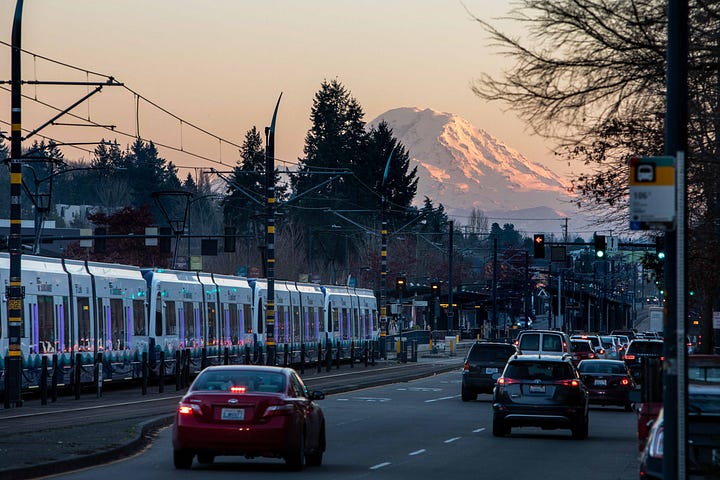
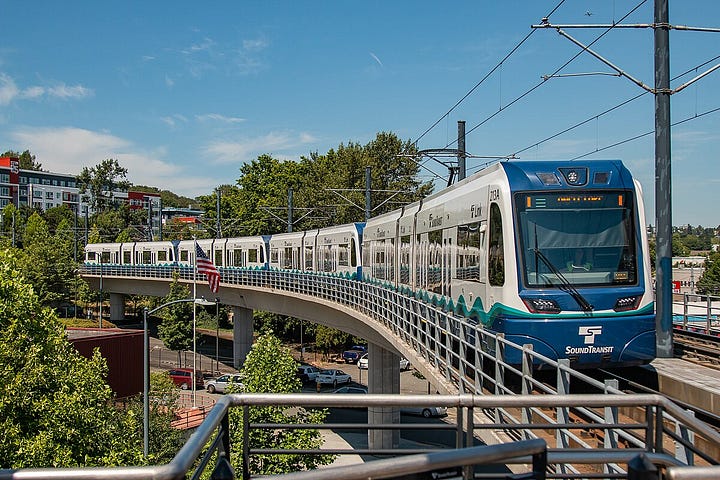
It’s worth noting that some FRA trains also operate in the middle of roads, as relics from the interurban era. Those are fine, and I think most light rail systems running in the median of streets can adopt that regulatory structure. In fact, the Metra Electric from earlier in the article proves a great example of how that can look:
The second type of light rail is the streetcar, which looks like this:
Streetcars are stupid. They’re uniformly very short, often do not even collect fares. Almost 100% of the time, they have a parallel bus route which is faster, and sometimes even more frequent. There are a few of these systems around the US, and every single one of them is a worse use of funds than Bus Rapid Transit. If there is a place to draw a regulatory barrier to prevent a mode from existing, this is the place. The current ones can be left as is, or maybe placed in the same category as PATH is now.
VI. Avenues For Reform
As with any system, regulatory barriers stay up because there usually do exist some winners from it. FTA grants go to blue cities, almost exclusively, while FRA grants benefit either freight rail, or redder and more affluent suburbs. Since FRA granted projects are more cost effective, the losers from this change would be blue city systems.
Furthermore, some smaller cities only operate buses. When they first set out to build rail, the grants are from the same places as BRT (which more cities have). Switching grant makers may make it harder for some systems (see especially Austin) from climbing the ladder. The biggest losers, however, are probably current employees of the FTA - just because agency turmoil puts some jobs in danger.
Because of that, agency reorganization can only happen if the federal Department of Transportation wants it to happen. This sort of agency shift is much more popular among Republicans than it is among Democrats, so combined with the blue/red disparity mentioned earlier, it would happen under a Republican president, if at all.
Ideally, I would say that republicans should just put it into their platform. They could say something like:
reform rail transportation grants to prioritize cost-efficiency and use of existing infrastructure
eliminate excessive bureaucracy separating urban and suburban trains, creating a smoother passenger experience
Stop funding to ludicrously expensive subway extension projects in blue cities
Which wouldn’t explicitly point at moving the agency gap. Alternatively, they could just say they’d transfer jurisdiction of railroads outright. Unfortunately, the Republican Party platform released today, and it doesn’t contain any serious thoughts about transit at all. After complaining about the Highway Trust Fund, this is all they have to say on the matter of local transit:
Nobody seems to have thought about this. They could close the FTA grants program, but that would only last until the next democratic trifecta, which would reverse it. Plus, transit does need to get funded somehow.
Project 2025 was similarly vague about what they wanted to do with transit grants and the department of transportation. Heritage doesn’t write about it. The America First Policy Institute (allegedly Trump’s think tank) doesn’t even mention transportation. Nobody in republican politics is talking about rail at all.
If I’m right, and it’s in fact true that zero republicans are writing about transit, then I think they should do this. It would be nice for them to take it seriously, for a change.





Streetcars should be allowed to exist because they are adorable.